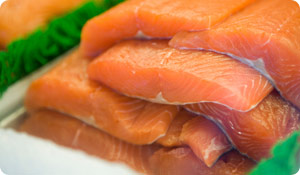
When you shop for seafood, you'll probably find a variety of salmon types to choose from—some caught in the wild and some raised on fish farms. With fish, "farm-raised" means utilizing the now decades-old but ever-improving science and technology of aquaculture. Today, half the fish and shellfish consumed by humans around the world come from fish farms. Although this agricultural development has the potential to provide billions of people with an inexpensive source of protein and healthful fats, the benefits appear to come with environmental issues that may have health consequences.
Wild salmon is higher in protein, while farm-raised salmon is generally higher in essential omega-3 fatty acids, the type of fat that is thought to protect against heart disease and other chronic medical conditions. Any debate on the value of wild vs. farm-raised salmon focuses less on the nutritional variations, however, than on a concern about the levels of toxic compounds detected in the two types.
Mercury in seafood has always been a concern, especially for pregnant women and young children, because almost all types of fish contain mercury which, over time, can accumulate in the bloodstream and reach toxic levels. Fresh, frozen or canned salmon are generally all considered low-mercury fish, regardless of the source. Other environmental toxins, however, have proven to be a potential problem, especially in farmed salmon.
PCBs (polychlorinated biphenyls) are industrial chemicals that were banned from use in the U.S. during the 1980s after toxic amounts were found to be accumulating in the environment. Trace amounts of PCBs and a variety of other chemicals are still present in the natural water supply all these years later, and can end up in the fatty tissues of fish that swim in contaminated waters. Investigative reports have revealed that while farm-raised and wild salmon contain PCB levels that are well within established safety limits, the levels in farm-raised salmon can be as much as twelve times higher than those in wild salmon. As recently as 2005, a study published in the journal Environmental Science & Technology found that farm-raised salmon are significantly higher in many contaminants than wild salmon.
Wild Alaskan salmon (which you may see in the supermarket and fish market as coho, pink, sockeye, chum, Chinook or king salmon) are among the fish listed by the Environmental Defense Fund and other organizations that monitor toxins in seafood as being low in contaminants such as PCBs and generally healthy fish. Among the various species of wild salmon, however, Chinook has tested higher in several chemical pollutants than others possible due to a difference in individual feeding habits. Overall, wild Alaskan salmon are also favored by environmentalists because they are caught with fishing gear that does little to disturb the natural environment from which they are caught.
Sources:
University of Southern Maine: Salmon Nutrition: How Different Varieties of Salmon Compare:
http://usm.maine.edu/wellness/special_features/salmon_nutrition.htm
New Jersey Agricultural Experiment Station at Rutgers University/PCBs and Dioxins:
http://njaes.rutgers.edu/seafoodsafety/sspcb.html
Environmental Defense Fund:
PCBs:
http://www.edf.org/page.cfm?tagID=15904
Wild Alaskan Salmon:
http://www.edf.org/page.cfm?tagID=16281
Environmental Science & Technology/Abstract (2005):
http://www.ncbi.nlm.nih.gov/pubmed/15506184
U.S. Fish and Wildlife Service/CT River/Background:
http://www.fws.gov/r5crc/contaminant_loads.htm
Original study that started the debate:
http://www.albany.edu/ihe/salmonstudy/salmon_study.pdf





